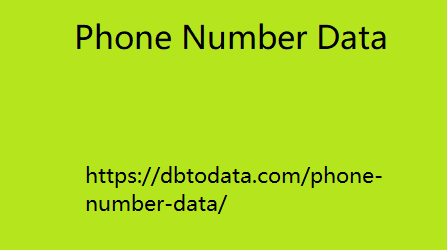In today’s data-driven world, regularly analyzing data is essential for making informed decisions and staying ahead of the competition. By tracking key metrics, identifying trends, and uncovering insights, you can optimize your business operations, improve customer satisfaction, and drive growth.
Why Analyze Data Regularly?
Identify Trends: Regular data analysis Denmark Phone Number Data helps you identify emerging trends and patterns that can inform your decision-making.
Measure Performance: By tracking key metrics, you can measure the performance of your business or project and identify areas for improvement.
Make Data-Driven Decisions: Data analysis provides the evidence needed to make informed and strategic decisions.
Optimize Operations:
By analyzing data, you can identify inefficiencies and optimize your operations to improve efficiency and reduce costs.
Enhance Customer Experience: Understanding customer data can help you tailor your products and services to meet their needs and preferences.
Key Metrics to Analyze
Financial Metrics: Revenue, profit, return KYB Directory on investment (ROI), cost per acquisition (CPA), customer lifetime value (CLTV).
Marketing Metrics: Website traffic, social media engagement, conversion rates, customer acquisition cost.
Sales Metrics: Sales revenue, sales quotas, average order value, customer satisfaction.
Operational Metrics: Productivity, efficiency, defect rates, lead times.
Customer Satisfaction Metrics: Customer satisfaction ratings, net promoter score (NPS).
Data Analysis Tools
Business Updated 2024 Mobile Phone Number Resource Intelligence (BI) Tools: Tableau, Power BI, QlikView.
Data Mining Tools: RapidMiner, KNIME, Orange.
Statistical Software: SPSS, R, Python.
Best Practices for Data Analysis
Set Clear Goals: Define the specific questions you want to answer through data analysis.
Clean and Prepare Data: Ensure data quality and accuracy before analysis.
Choose Appropriate Metrics: Select metrics that are relevant to your goals and provide valuable insights.
Use Visualization Tools: Create visualizations (charts, graphs) to make data easier to understand and interpret.
Share Insights: Communicate your findings to relevant stakeholders and use the insights to inform decision-making.
By regularly analyzing data, you can gain a competitive advantage, make data-driven decisions, and optimize your business operations. Remember, data is a valuable asset, and effective analysis can help you unlock its full potential.

